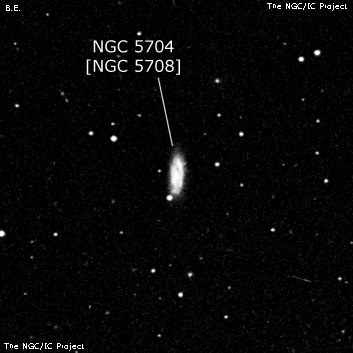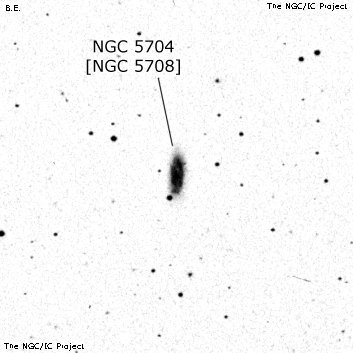NGC/IC Project Restoration Effort
(This is a very very beta version)
NGC5704


Basic Information
Location and Magnitude
Right Ascension: 14:38:16.2
Declination: +40:27:28
Constellation: BOO
Visual Magnitude: 13.3
Historic Information
Discoverer: Herschel W.
Year of discovery: 1787
Discovery aperture: 18.7
Observational
Summary description: F, cS, lE 0° ±
Sub-type: Sd
Corwin's Notes
=====
NGC 5704 is probably = NGC 5708. There is no doubt that WH's object (II 649)
is NGC 5708; his description matches, and his position is just about 1.6
arcmin north-northeast of the galaxy.
JH, however, has the number on the one observation of his in the area that
does not apply to the galaxy. That one night, JH's position ends up almost
exactly on the preceding star of a wide double (the position angle is about
100 degrees) -- is it possible that he mistook it for a nebula? His
description, "F, S, R," barely supports this notion, with the shape being at
variance with his father's "F, S, E nearly mer., r." Note, in particular,
that WH has the galaxy extended north-south (as it actually is), not nearly
east-west as the orientation of the double star would have it. His final
comment ("r" = mottled) is probably due to the star superposed on the south-
east edge of the galaxy, as well as the rather patchy nature of the object
itself.
On that same night, JH has another observation of what he calls a "nova"
which is nevertheless clearly the same galaxy. The position agrees with his
father's, and his description "F, pL, E nearly in merid.; gbM" does, too.
JH has one other observation that he credits to the first of these two
objects, but he comments that the position is bad. He apparently did not
notice that that "bad" position is identical to his two positions for NGC
5708 (the mean of his three positions is only 15 arcsec off the galaxy).
So, the only puzzle is the position of the object found by JH which received
the NGC number 5704. This is the position given in GC and NGC, and as I noted
above, is close to the western component of a double star. However, since
there is only one galaxy here, and since it is clear that both Herschel's saw
it, I am going to put both NGC numbers on the object. But we do have to keep
in mind that JH claimed to have seen two nebulae here on one night, so it is
still possible that we could claim NGC 5704 as the star.
-----
The sweeps give us no clues. None of the observations there are marked
uncertain; that only happens in JH's 1833 PT catalogue. Given that JH's
"nova" is clearly identical with his father's II 649, I've finally set the two
NGC numbers to apply to the single galaxy here. I have, however, left the one
discrepant position in the list with the number "NGC 5704?" just to indicate
the final unresolved uncertainty.
Steve's Notes
=====
NGC 5704
See observing notes for NGC 5708.



